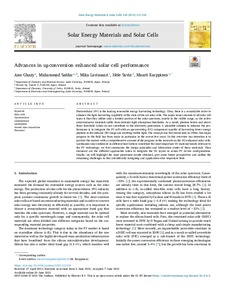Advances in upconversion enhanced solar cell performance
Ghazy Amr; Safdar Muhammad; Lastusaari Mika; Savin Hele; Karppinen Maarit
https://urn.fi/URN:NBN:fi-fe2021093048655
Tiivistelmä
Abstract
Photovoltaics (PV) is the leading renewable energy harvesting technology. Thus, there is a remarkable strive to enhance the light harvesting capability of the state-of-the-art solar cells. The major issue common to all solar cell types is that they utilize only a limited portion of the solar spectrum, mostly in the visible range, as the active semiconductor materials suffer from intrinsic light absorption thresholds. As a result, photons below and above these threshold values do not contribute to the electricity generation. A plausible solution to enhance the performance is to integrate the PV cell with an upconverting (UC) component capable of harvesting lower energy photons in the infrared (IR) range and emitting visible light. The concept was first introduced in 1990s, but major progress in the field has been made in particular in the recent few years. In this overview our intention is to provide the readers with a comprehensive account of the progress in the research on the UC-enhanced solar cells. Lanthanide ions embedded in different host lattices constitute the most important UC material family relevant to the PV technology; we first summarize the design principles and fabrication routes of these materials. Then discussed are the different approaches taken to integrate the UC layers in actual PV device configurations. Finally, we will highlight the most prominent results obtained, give some future perspectives and outline the remaining challenges in this scientifically intriguing and application-wise important field.
Kokoelmat
- Rinnakkaistallenteet [27094]
